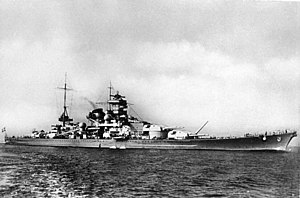
Back Scharnhorst Afrikaans البارجة الألمانية شارنهورست Arabic Шарнхорст (линеен кораб, 1936) Bulgarian Creuer Scharnhorst Catalan Scharnhorst (1935) Czech Scharnhorst (slagskib) Danish Scharnhorst (Schiff, 1939) German Scharnhorst (1939) Spanish Scharnhorst (lahingulaev) Estonian رزمناو شارنهورست Persian
 Scharnhorst
| |
| History | |
|---|---|
| Name | Scharnhorst |
| Namesake | Gerhard Johann von Scharnhorst (1755–1813)[1] |
| Builder | Kriegsmarinewerft Wilhelmshaven |
| Laid down | 15 June 1935 |
| Launched | 3 October 1936 |
| Commissioned | 7 January 1939 |
| Motto | Scharnhorst immer voran (Scharnhorst ever onward)[2] |
| Fate | Sunk at the Battle of the North Cape on 26 December 1943 |
| General characteristics | |
| Class and type | Scharnhorst-class battleship |
| Displacement |
|
| Length | 234.9 m (770 ft 8 in) |
| Beam | 30 m (98 ft 5 in) |
| Draft | 9.9 m (32 ft 6 in) |
| Installed power | 159,551 shp; 118,977 kW[3] |
| Propulsion | 3 Brown, Boveri & Co geared steam turbines |
| Speed | 31 knots (57 km/h; 36 mph) |
| Range | 7,100 nmi (13,100 km; 8,200 mi) at 19 knots (35 km/h; 22 mph) |
| Complement |
|
| Armament |
|
| Armor |
|
| Aircraft carried | 3 Arado Ar 196A |
| Aviation facilities | 1 catapult |
Scharnhorst was a German capital ship, alternatively described as a battleship or battlecruiser, of Nazi Germany's Kriegsmarine. She was the lead ship of her class, which included her sister ship Gneisenau. The ship was built at the Kriegsmarinewerft dockyard in Wilhelmshaven; she was laid down on 15 June 1935 and launched a year and four months later on 3 October 1936. Completed in January 1939, the ship was armed with a main battery of nine 28 cm (11 in) C/34 guns in three triple turrets. Plans to replace these weapons with six 38 cm (15 in) SK C/34 guns in twin turrets were never carried out.
Scharnhorst and Gneisenau operated together for much of the early portion of World War II, including sorties into the Atlantic to raid British merchant shipping. During her first operation in November 1939, Scharnhorst sank the armed merchant cruiser HMS Rawalpindi in a short engagement. Scharnhorst and Gneisenau participated in Operation Weserübung, the German invasion of Norway, from April to June 1940. During operations off Norway, the two ships engaged the battlecruiser HMS Renown and sank the aircraft carrier HMS Glorious as well as her escort destroyers Acasta and Ardent. In that engagement Scharnhorst achieved one of the longest-range naval gunfire hits in history.
In early 1942, after British bombing raids, the two ships made the Channel Dash up the English Channel from occupied France to Germany. In early 1943, Scharnhorst joined the Bismarck-class battleship Tirpitz in Norway to interdict Allied convoys to the Soviet Union. Scharnhorst and several destroyers sortied from Norway to attack a convoy but British naval patrols intercepted the German force. During the Battle of the North Cape (26 December 1943), the Royal Navy battleship HMS Duke of York and her escorts sank Scharnhorst. Only 36 men survived, out of a crew of 1,968.